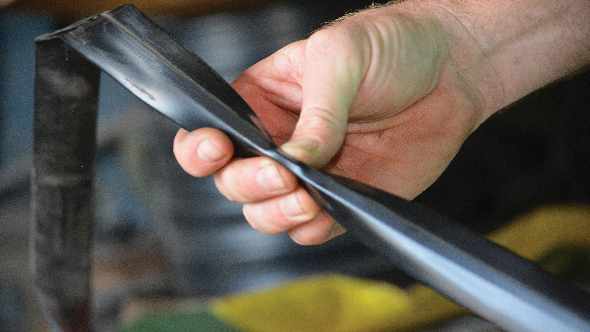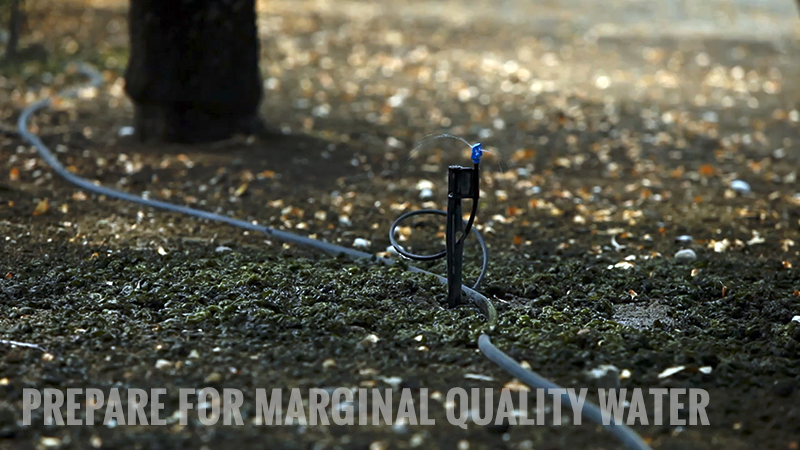Florida Growers Seize Control Of Water Challenges

Bryan Jones says the combination of fertilizer banding equipment and enhanced subsurface drip irrigation will go a long way toward helping reduce nutrient runoff, reducing input costs, and potentially increasing productivity.
Photo by Frank Giles
The Lower St. Johns River has been in the spotlight in recent years as water quality issues and algal blooms have topped the headlines. As is often the case, agriculture is singled out in the media as a guilty party.
But, growers in the Tri-County Agricultural Area (TCAA) are stepping up to the challenge, partnering with a number of agencies to cost-share projects aimed at addressing water concerns. Bryan Jones has rallied growers in the area to try alternative irrigation and fertilization techniques to reduce nutrient runoff in waterways like the St. Johns.
Jones farms with his father Richard in St. Augustine on their Riverdale Farms. The family grows potatoes, corn, green beans, and sod. He says potato farmers in particular can benefit from new practices, which protect water resources and can result in better yields and quality. And, he is passionate about the cause.
“I believe the Tri-County area can be an example to the state, the region, and the country,” Jones says. “We are still finalizing the data on how much water we are saving with UF/IFAS researchers, but when we do, it is going to be jaw-dropping. I am proud of our work here.”

Bryan Jones
Photo by Frank Giles
Jones was recognized as one of Florida Ag Commissioner Adam Putnam’s 2014 Agricultural-Environmental Leadership Award winners for his work with subsurface drip seepage irrigation.
“I am honored by the award, but I also want to be sure that all the great things growers in this area are doing to protect our land and water are applauded,” he says.
Enhanced Seepage
Jones got turned on to a potential new irrigation tactic when visiting the Sun Belt Expo several years ago and learning how some row crop growers were using drip irrigation.
“My dad and I were at the show and we learned how some cotton and peanut growers in Georgia were using drip placed below the bed. A light bulb went off that this could possibly be applied to potatoes and other crops in our area,” he says.
The approach has been adapted for potatoes on some of Riverdale Farms’ acres to replace traditional seepage irrigation, which is slow and utilizes large volumes of water. A 7/8, 15-mil. drip tape with emitters spaced 12 inches apart is installed below the soil.
“We are placing the tape 14 inches below the alley, so it won’t get damaged by tillage equipment,” Jones says. “We don’t know how long we are going to get out of the tape, but we are going into our fourth season and it is holding up. We might get 15 years out of the tape. If not, we’ll pull it out and replace it. The tape is the least expensive part of the project.”
Unlike cotton and peanuts where tape goes under every row, Jones is installing two or three lines per 60-foot bed, and the efficiency it brings to watering potatoes is astonishing he says. The tape is placed 26 feet apart and will irrigate four rows to the right and four to the left. On hard irrigating ground, a third line is placed in the center of the bed to allow for more water.
“On some of our conventional ground, it might take a couple of weeks for the water to move down the furrow to the other end of the field,” Jones says. “That’s just getting down to the other end, not seeping out into the middles of the beds.
“With the tape, I can turn on the system at the well, get in my pickup and drive to the other side of the field and water is already seeping out. It is so fast and so effective that we now use moisture sensors in the fields so we don’t overdo it.”
With conventional seepage in an average season, large quantities of water are required to irrigate potatoes — up to 300,000 to 400,000 gallons per acre.
“We are pumping water 24/7 for six to eight weeks,” Jones says. “On good irrigating ground, once I bring the water table up, I can run only eight hours per week using the drip tape. We expect we will achieve 80% water-use efficiency.
“With conventional seepage, the first and sometimes second outside rows of the beds are going to stay wetter and it stresses the plants, so we can see yield loss on those rows. We can eliminate this with the drip. We have the tape spaced out evenly in the bed, so we can bring the water up and down evenly. This creates a uniform environment for the plants to grow.”
Because of the positive benefits resulting from the enhanced drip seepage, Jones says he’d like to install tape on all the farm’s acres over time. “We are adding a little more tape each season, starting with our tougher ground first,” he says. “And, it is opening up land we couldn’t farm before. We had some old ground where a pond had been filled in, and with conventional seepage, it simply would not irrigate. UF/IFAS researchers who looked at the field couldn’t figure out why the water would not percolate through the soil. We put drip tape in that field, and within days, we had standing water. It is amazing.”
Drop It Where It Counts
Another cost-share opportunity Riverdale Farms has taken advantage of is an investment in dry fertilizer banding equipment. Jones is using the equipment on all of the farm’s potato acres, saving fertilizer by precisely laying it on top of the rows.
“We purchased one of the banding machines through the partnership and my dad purchased another one on his own to be sure we can cover all our acres if we get behind because of weather,” Jones says. “It is a wonderful piece of equipment that — combined with the drip tape — leaves very minimal waste.”
Precision Application
Jones is providing a vendor service helping other growers install drip systems on their farms.
“One of my stipulations with growers is using GPS guidance to install the drip tape,” he says. “If we don’t use it, the row can move on you and we want the line laid in as straight as possible.”

Using subsurface drip irrigation can provide growers much more control over water distribution to fields and ultimately save millions of gallons in usage. Photo by Frank Giles
The fertilizer banding equipment is operated by a Raven controller, which speeds up or slows down the chain based upon the amount of fertilizer that needs
to be applied.
“It is very precise,” Jones says. “We also use it to control the flow valves on our sprayers to apply the exact right amount, so we are not guessing.”
Potato Payoff
To install the drip system and buy banding equipment is not cheap. Will the investments pay off beyond environmental benefits with better yields and quality? Jones believes so and he says early results say yes.
“We are still trying to establish our yield benefits because the last two seasons we had weather issues that skewed our results,” he says. “However, the first year we installed the project we had two 25-acre fields side-by-side to compare conventional irrigation to our enhanced drip seepage with banded fertilizer. We harvested two semi-truck loads of potatoes more off the drip/banded field. Depending on your contract price, that’s $10,000 more off a little 25-acre block. It doesn’t take long to recoup the investment.”
Changing Times
While dealing with regulatory agencies can often be a frustrating process filled with red tape and inexplicable delays, Jones encourages other growers to investigate cost-share opportunities to preserve water resources.
“Some of these of things are generational and people have a hard time with more and more regulations,” Jones says. “But, times are changing and we are going to get left behind if we don’t adapt and stay ahead of the curve. Agriculture is so important to this country that we have to do it.
“Most of our growers already are going above and beyond what they need to do, so we are heading in the right direction. If we can get better yields and use less water and fertilizer on the front end, it is a double win that I am beyond excited about.”
Partnering To Protect Water Resources
Riverdale Farms has participated in the Tri-County Agricultural Area Water Management Partnership (TCAA-WMP) cost-share program. The program is a collaboration among growers, agencies, ag associations, and others to address agricultural nutrient loadings to the Lower St. Johns River. The growers propose projects like subsurface-enhanced drip seepage irrigation that they think will work for their production schemes, which also have water quality and often water conservation benefits.
FDACS, St. Johns River Water Management District, Florida Department of Environmental Protection (FDEP), and USDA’s Natural Resources Conservation Service are the funding technical support agencies. UF/IFAS provides technical and Extension support and is under contract with FDEP to monitor some of the projects for water quality improvements.
“A grower must be enrolled in and implementing FDACS BMPs, be in compliance with any applicable regulations, be located in the TCAA, and have been in production for the previous three years to be eligible for the cost-share,” says Terry Pride, an environmental administrator with FDACS. “There are few other criteria, but those are the key ones.”
The cost-share program will cover 75% of expenses for the design and construction of projects like subsurface drip or drain tile for up to 100 acres (150 acres for overhead improvements). For equipment improvement like the banded fertilizer applicator, the cost-share covers 75% of expenses up to $75,000.
“Irrigation system improvements should have a significant impact on reducing nutrient discharges from the TCAA to the Lower St. Johns River, assuming that growers continue to expand their use,” Pride says. “As Bryan Jones has noted, with the subsurface enhanced drip seepage and fertilizer banding, less nutrients are leaving the field. He estimates that the banding equipment has reduced their fertilizer use by 60 to 75 tons. With these two measures, crop production and profit increased, while discharges decreased.
“At another TCAA farm, installation of a center pivot irrigation system on sod saved more than 428 million gallons of water over conventional seepage during the first year of its use. And, the use of a new fertilizer spreader cut fertilizer use by 10% to 15% just by avoiding the furrows.”
For more information on the cost-share program, contact Jody Lee, FDACS field representative, at 386-329-4812 or [email protected].










